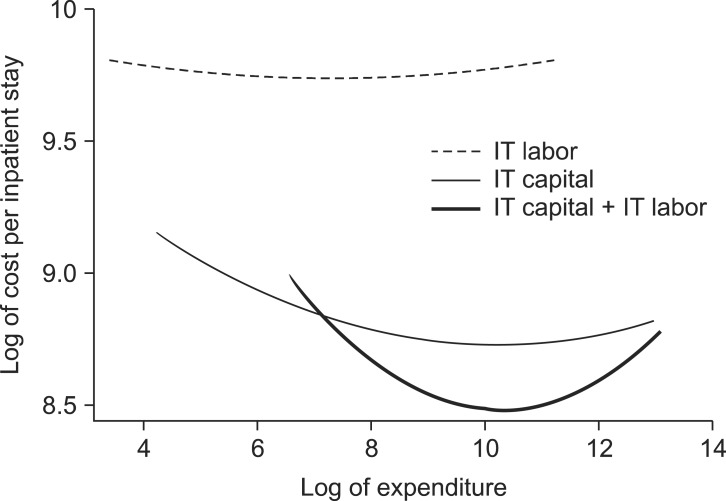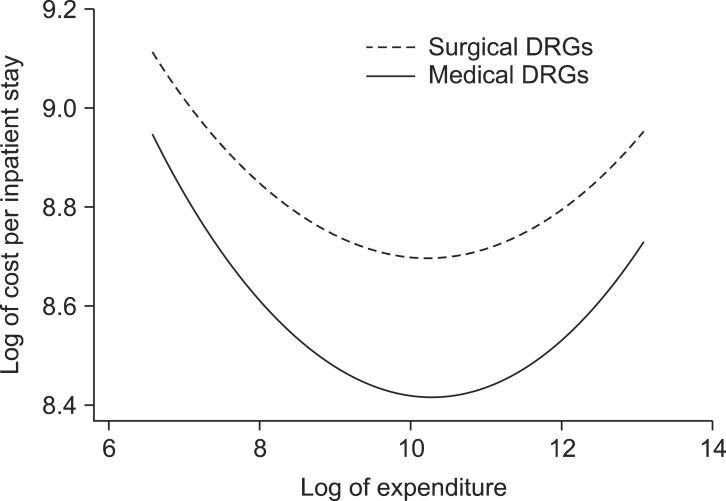Effect of Health Information Technology Expenditure on Patient Level Cost
- Affiliations
-
- 1Health Policy and Management, Jiann-Ping Hsu College of Public Health, Georgia Southern University, Statesboro, GA, USA. leejinh@gmail.com
- 2Division of Health Policy and Management, School of Public Health, University of Minnesota, Minneapolis, MN, USA.
- KMID: 2166700
- DOI: http://doi.org/10.4258/hir.2013.19.3.215
Abstract
OBJECTIVES
This study investigate the effect of health information technology (IT) expenditure on individual patient-level cost using California Office of Statewide Health Planning and Development (OSHPD) data obtained from 2000 to 2007.
METHODS
We used a traditional cost function and applied hospital fixed effect and clustered error within hospitals.
RESULTS
We found that a quadratic function of IT expenditure best fit the data. The quadratic function in IT expenditure predicts a decrease in cost of up to US$1,550 of IT labor per bed, US$27,909 of IT capital per bed, and US$28,695 of all IT expenditure per bed. Moreover, we found that IT expenditure reduced costs more quickly in medical conditions than surgical diseases.
CONCLUSIONS
Interest in health IT is increasing more than ever before. Many studies examined the effect of health IT on hospital level cost. However, there have been few studies to examine the relationship between health IT expenditure and individual patient-level cost. We found that IT expenditure was associated with patient cost. In particular, we found a quadratic relationship between IT expenditure and patient-level cost. In other word, patient-level cost is non-linearly (or a polynomial of second-order degree) related to IT expenditure.
Keyword
Figure
Cited by 4 articles
-
Factors Affecting Electronic Medical Record System Adoption in Small Korean Hospitals
Young-Taek Park, Jinhyung Lee
Healthc Inform Res. 2014;20(3):183-190. doi: 10.4258/hir.2014.20.3.183.Effects of Health Information Technology on Malpractice Insurance Premiums
Hye Yeong Kim, Jinhyung Lee
Healthc Inform Res. 2015;21(2):118-124. doi: 10.4258/hir.2015.21.2.118.Association of EMR Adoption with Minority Health Care Outcome Disparities in US Hospitals
Jae-Young Choi, Yong-Fang Kuo, James S. Goodwin, Jinhyung Lee
Healthc Inform Res. 2016;22(2):101-109. doi: 10.4258/hir.2016.22.2.101.Association between Health Information Technology and Case Mix Index
Young-Taek Park, Junsang Lee, Jinhyung Lee
Healthc Inform Res. 2017;23(4):322-327. doi: 10.4258/hir.2017.23.4.322.
Reference
-
1. Lee J, McCullough JS, Town RJ. The impact of health information technology on hospital productivity. Cambridge (MA): National Bureau of Economic Research;2012.2. American Recovery and Reinvestment Act of 2009: Public Law 111-5. Washington (DC): United States Congress;2009.3. Taylor R, Bower A, Girosi F, Bigelow J, Fonkych K, Hillestad R. Promoting health information technology: is there a case for more-aggressive government action? Health Aff (Millwood). 2005; 24(5):1234–1245. PMID: 16162568.
Article4. Chaudhry B, Wang J, Wu S, Maglione M, Mojica W, Roth E, et al. Systematic review: impact of health information technology on quality, efficiency, and costs of medical care. Ann Intern Med. 2006; 144(10):742–752. PMID: 16702590.
Article5. Garg AX, Adhikari NK, McDonald H, Rosas-Arellano MP, Devereaux PJ, Beyene J, et al. Effects of computerized clinical decision support systems on practitioner performance and patient outcomes: a systematic review. JAMA. 2005; 293(10):1223–1238. PMID: 15755945.6. Institute of Medicine. Crossing the quality chasm: a new health system for the 21st century. Washington (DC): National Academies Press;2001.7. Institute of Medicine. Quality through collaboration: the future of rural health care. Washington (DC): National Academies Press;2005.8. Kuperman GJ, Gibson RF. Computer physician order entry: benefits, costs, and issues. Ann Intern Med. 2003; 139(1):31–39. PMID: 12834316.
Article9. Borzekowski R. Measuring the cost impact of hospital information systems: 1987-1994. J Health Econ. 2009; 28(5):938–949. PMID: 19699542.
Article10. McCullough JS, Casey M, Moscovice I, Prasad S. The effect of health information technology on quality in U.S. hospitals. Health Aff (Millwood). 2010; 29(4):647–654. PMID: 20368594.
Article11. Parente ST, McCullough JS. Health information technology and patient safety: evidence from panel data. Health Aff (Millwood). 2009; 28(2):357–360. PMID: 19275990.
Article12. Parente ST, Van Horn RL. Valuing hospital investment in information technology: does governance make a difference. Health Care Financ Rev. 2006; 28(2):31–43. PMID: 17427843.13. Girosi FR, Meili R, Scoville RP. Extrapolating evidence of health information technology savings and costs. Santa Monica (CA): RAND Health;2005.14. Menachemi N, Burkhardt J, Shewchuk R, Burke D, Brooks RG. Hospital information technology and positive financial performance: a different approach to finding an ROI. J Healthc Manag. 2006; 51(1):40–58. PMID: 16479749.
Article15. Menon NM, Lee B, Eldenburg L. Productivity of information systems in the healthcare industry. Inf Syst Res. 2000; 11(1):83–92.
Article16. Thouin MF, Hoffman JJ, Ford EW. The effect of information technology investment on firm-level performance in the health care industry. Health Care Manage Rev. 2008; 33:60–68. PMID: 18091445.
Article17. Hensing J, Dahlen D, Warden M, Van Norman J, Wilson BC, Kisiel S. Measuring the benefits of IT-enabled care transformation. Healthc Financ Manage. 2008; 62(2):74–80. PMID: 18309597.18. Furukawa MF, Raghu TS, Shao BB. Electronic medical records, nurse staffing, and nurse-sensitive patient outcomes: evidence from California hospitals, 1998-2007. Health Serv Res. 2010; 45(4):941–962. PMID: 20403065.
Article19. DesRoches CM, Campbell EG, Vogeli C, Zheng J, Rao SR, Shields AE, et al. Electronic health records' limited successes suggest more targeted uses. Health Aff (Millwood). 2010; 29(4):639–646. PMID: 20368593.
Article20. Amarasingham R, Plantinga L, Diener-West M, Gaskin DJ, Powe NR. Clinical information technologies and inpatient outcomes: a multiple hospital study. Arch Intern Med. 2009; 169(2):108–114. PMID: 19171805.21. Lee J, Park YT. Measure of clinical information technology adoption. Healthc Inform Res. 2013; 19(1):56–62. PMID: 23626919.
Article22. State of California, Office of Statewide Health Planning and Development (OSHPD) [Internet]. Sacramento (CA): OSHPD;c2011. cited at 2013 Sep 1. Available from http://www.oshpd.ca.gov/.23. Gowrisankaran G, Town RJ. Estimating the quality of care in hospitals using instrumental variables. J Health Econ. 1999; 18(6):747–767. PMID: 10847933.
Article24. Research Data Assistant Center (RESDAC). Using Medicare hospital cost reports cost-to-charge ratios in research [Internet]. Minneapolis (MN): RESDAC;2010. cited at 2013 Sep 1. Available from: http://www.resdac.umn.edu.25. Friedman B, De La Mare J, Andrews R, McKenzie DH. Practical options for estimating cost of hospital inpatient stays. J Health Care Finance. 2002; 29(1):1–13. PMID: 12199491.26. Lave JR, Pashos CL, Anderson GF, Brailer D, Bubolz T, Conrad D, et al. Costing medical care: using medicare administrative data. Med Care. 1994; 32(7 Suppl):JS77–JS89. PMID: 8028415.27. Hayes KJ, Pettengill J, Stensland J. Getting the price right: medicare payment rates for cardiovascular services. Health Aff (Millwood). 2007; 26(1):124–136. PMID: 17211021.
Article28. Gapenski LC. Healthcare finance: an introduction to accounting and financial management. 5th ed. Chicago (IL): Health Administration Press;2012.29. Ingenix. DRG expert: a comprehensive guidebook to the DRG classification system. Reston (VA): Ingenix;2007.30. Rosenberg N. Factors affecting the diffusion of technology. Explor Econ Hist. 1972; 10(1):3–33.
Article
- Full Text Links
- Actions
-
Cited
- CITED
-
- Close
- Share
- Similar articles
-
- Effect of Health Information Technology Expenditure on Patient Level Cost
- Impacts of the Implementation of the DRG Based Prospective Payment System on the Medicare Expenditures
- Analysis of Influencing Factors of High-Cost Beneficiaries of Catastrophic Health Expenditure Support Project
- Cost-Benefit Analysis of the Sharing System for Electronic Patients Records Among Healthcare Institutions
- Trends in Scale and Structure of Korea's Health Expenditure over Last Three Decades (1980-2009): Financing, Functions and Providers



